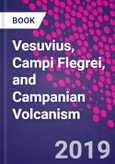Vesuvius, Campi Flegrei, and Campanian Volcanism communicates the state-of-the-art scientific knowledge on past and active volcanism in an area characterized by elevated risk due to high-density population. Eruptions, lahars and poisonous gas clouds have killed many thousands of people over recorded history, but volcanoes have given people some of the most fertile soil known in agriculture. The research presented in this book is useful for policymakers and researchers from these and other countries who are looking for risk assessment and volcanic evolution models they can apply to similar situations around the world.
Naples and its surrounding area, in particular, the area situated between Vesuvius and the Campi Flegrei volcanic area has a population in excess of 4 million people. The volcanic areas that have similarly large populations in proximity to dormant, but hazardous volcanoes, i.e., Indonesia and Central America can also benefit from this work.
Please Note: This is an On Demand product, delivery may take up to 11 working days after payment has been received.
Table of Contents
1. The volcanological history of Campania volcanism�2. The contributions and influence of two Americans, H.S. Washington and F.A. Perret, to the study of Italian volcanism with emphasis on Neapolitan volcanoes�
3. Kinematic framework of the Tyrrhenian-Apennine system and consequences for Camapian magmatism�
4. Lithosphere structural model of the Campania�
5. Campanian volcanoes: petrology, geochemistry and geodynamic implications�
6. Tracing magma evolution at Vesuvius volcano using melt inclusions: a review�
7. Magmatism of the Phlegrean Volcanic Fields as revealed by melt inclusions�
8. The 39 ka Campanian Ignimbrite eruption: new data on volcanic source area in the Campanian Plain�
9. Effects of the paleomorphology on facies distribution of the Campanian Ignimbrite in the northern Campanian Plain
10. Petrogenesis of the Campanian Ignimbrites: a review�
11. The 15 ka Neapolitan Yellow Tuff eruption: an analysis of the caldera-forming phase and the post-caldera volcanic activity�
12. Pre-volcanic, syn-volcanic and post-volcanic extensional faulting in the Campania margin�
13. Petrologic experimental data on Vesuvius and Campi Flegrei: a review�
14. Hydrothermal vs Magmatic: Geochemical clues into the unrest dilemma at Campi Flegrei�
15. Bradyseism at Campi Flegrei: a review�
16. The Holocene marine record of unrest, volcanism and hydrothermal activity of Campi Flegrei and Vesuvius�
17. Volcanological risk associated with Vesuvius and Campi Flegrei








